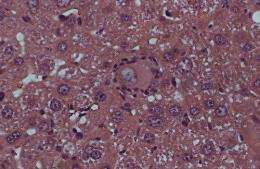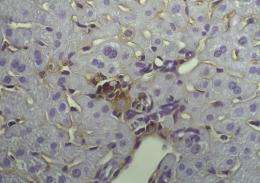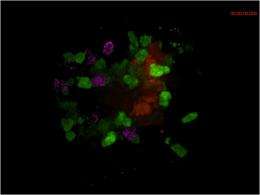Liver tissue section with a senescent liver cell directly in the center of the image. It is surrounded by small cells - attacking immune cells that have recognized and will have eliminated the senescent cell before long (Hämatoxylin-Eosin-stained section).
(Medical Xpress) -- Liver cell carcinoma is one of the most abundant malign cancer diseases worldwide. In the majority of cases its emergence is triggered by cirrhosis of the liver which is caused by chronic Hepatitis B or C virus infections. Researchers at the Helmholtz Centre for Infection Research (HZI) in Braunschweig and the Hanover Medical School have now revealed how a healthy and potent immune system is able to detect and kill potentially premalignant liver cells at an early stage. Cells with a high risk of degenerating into tumor cells – e.g. as a result of chemical stress or nuclear radiation – often abandon their normal life cycle and enter a state of arrest, designated as “senescence”.
Together with fellow researchers from other institutions the HZI scientists discovered that the state of senescence of the cells allows detection by the immune system. This results in an intensified surveillance by the body’s own defense system. The researchers propose that a mechanism, similar to the one shown for the liver, may play a key role in other organs as well. The results of this project have now been published in an online release by the scientific journal Nature.
Liver tissue section with a senescent liver cell directly in the center of the image. The senescent cell is stained homogenously brown. In the surrounding small immune cells are located that have recognized the senescent cell and will perform its elimination.
At the end of their life cycle or if their genetic information has been damaged or modified, cells either pass through a precisely organized programme of cell death or decline into a kind of “hibernation”, the so-called senescence. This resting state prevents defective cells from proliferating in an uncontrolled way and thus avoids the formation of tumors. Professor Lars Zender, head of the HZI research group Chronic Infections and Cancer, and his team were able to demonstrate that the immune system plays a crucial role in the continuous surveillance of these resting cells. “By this means the body avoids further alterations of cells that possibly result in cancer”, explains Lars Zender.
For the investigation of the association between senescence, immune defense and cancer development, Lars Zender and his team used molecular biological methods in order to induce the senescence programme in liver cells of laboratory mice. “We were distinctly able to see that the immune system initiates a reaction against the modified cells”, says Zender. After a few weeks the modified cells were eliminated.
The figure shows a liver tissue section. Multiple cells have been visualized using a fluorescence dye. A senescent liver cell (orange) is dying as it is being attacked by diverse immune cells. Among the attackers are cells of the innate immune system, stained in green (monocytes, macrophages, neutrophilic granulocytes) as well as cells of the acquired immune system, stained in purple (T-helper lymphocytes). The T-helper lymphocytes “instruct” the green cells to kill the senescent liver cell.
In immunodeficient mice that lack protective T-helper cells, researchers were able to observe that senescent liver cells progressed to develop liver cell carcinoma. “This clearly shows how important the surveillance of senescent cells is – a task carried out by the immune system, and specifically, by the T-helper cells”, says Zender.
This newly identified mechanism may also explain the fact that HIV-positive patients have an increased risk of developing liver cancer. To investigate this phenomenon, researchers determined the number of senescent cells in the liver of Hepatitis C patients that were also HIV-positive. The results were compared to the numbers of a Hepatitis C patient group without HIV infection. “As expected, in the former group the number of senescent cells was strongly increased”, says Zender. “In HIV patients, the T-helper cell-mediated immune defense is impaired. As a consequence, in livers of HIV patients, senescent liver cells probably cannot be eliminated effectively.”
The authors of this study are hopeful that the newly discovered mechanism enables the design of prospective new prevention and therapy strategies for cancer diseases.
More information:
Senescence surveillance of premalignant hepatocytes limits liver cancer development. Tae-Won Kang, Tetyana Yevsa, Norman Woller, Lisa Hoenicke, Torsten Wuestefeld, Daniel Dauch, Anja Hohmeyer, Marcus Gereke, Ramona Rudalska, Anna Potapova, Markus Iken, Mihael Vucur, Siegfried Weiss, Mathias Heikenwalder, Sadaf Khan, Jesus Gil, Dunja Bruder, Michael Manns, Peter Schirmacher, Frank Tacke, Michael Ott, Tom Luedde, Thomas Longerich, Stefan Kubicka and Lars Zender
Nature, Advanced Online Publication, DOI: 10.1038/nature10599
Journal information: Nature
Provided by Helmholtz Centre for Infection Research





















